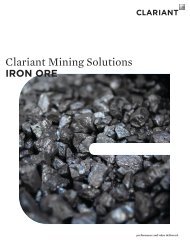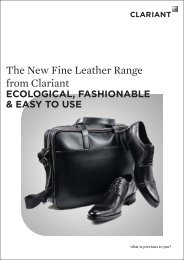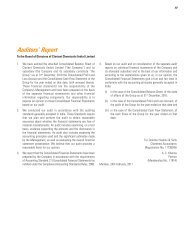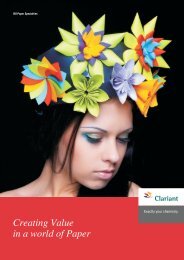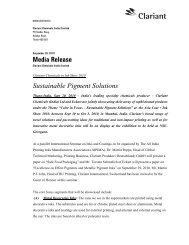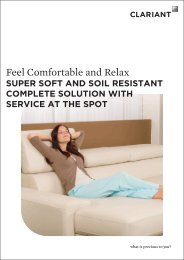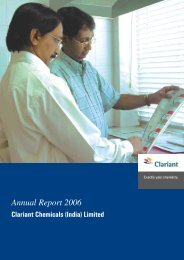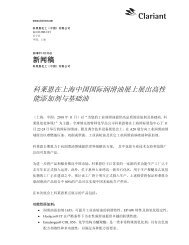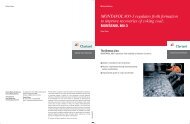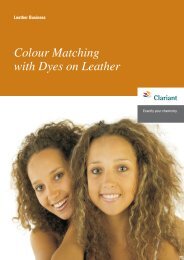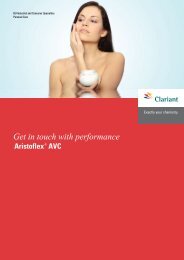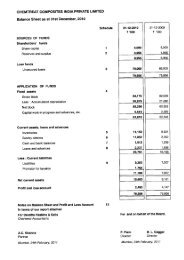Colour Chronicle - Mar 2011 - Clariant
Colour Chronicle - Mar 2011 - Clariant
Colour Chronicle - Mar 2011 - Clariant
You also want an ePaper? Increase the reach of your titles
YUMPU automatically turns print PDFs into web optimized ePapers that Google loves.
Number 1 | <strong>2011</strong><br />
<strong>Colour</strong> <strong>Chronicle</strong><br />
A <strong>Clariant</strong> Chemicals (India) Limited Publication<br />
for Textile, Leather and Paper<br />
32 nd year of publication
colour chronicle 1 | <strong>2011</strong><br />
Contents<br />
Textile 3<br />
Pad-Moist<br />
Wool/Silk Blend<br />
New Effect Lables 2010<br />
Q&A 12<br />
Textile - An Essential, Rich Heritage<br />
Leather 14<br />
<strong>Clariant</strong>’s customers are well-prepared for<br />
NMP-free future<br />
<strong>Clariant</strong>’s Easy white Tan to set new industry standard<br />
New Arrivals 17<br />
Inside View 18<br />
Gleanings from press 19<br />
2 colour chronicle 1 | <strong>2011</strong>
textile<br />
“Pad-Moist”<br />
A New Process for Dyeing<br />
Pad-Moist is characterized by the fact that no ancillary<br />
substances such as urea, silicate, and salt are required.<br />
Reactive dyestuff from “CLARIANT” which is highly reactive<br />
and highly fixative like Drimaren K and Drimaren HF-CD series<br />
can be used for Pad-Moist process. Significance of continuous<br />
dyeing with reactive dyes is to achieve economically efficient<br />
process of dyeing.<br />
Thermex modules for Maximum speed at different fabric weigh<br />
the Pad Moist process 100 g/m 2 200 g/m 2 300 g/m 2 100 g/m 2<br />
B Thermex B Fabric<br />
content 34 m 17 m/mm 14 m/mm – –<br />
C Thermex C Fabric<br />
content 40 m<br />
24 m/mm 21 m/mm 14 m/mm 10 m/mm<br />
Pad-Moist Process<br />
The fabric passes through the THERMEX hot flue with an air<br />
temperature of 110–130°C and a relative humidity of 25–30%<br />
inside the each chamber. Under these conditions the fabric<br />
is dried and at the same time dyestuff fixation takes place at<br />
68–71°C (The wet bulb temperature). This is the actual fixation<br />
condition for the dyestuff.<br />
The wet bulb temperature = the fabric temperature = the<br />
fixation temperature<br />
The thermex hot flue, utilizes evaporizing moisture from the<br />
wet fabric and here steam is injected at start up, to achieve the<br />
required degree of humidity needed for fixation.<br />
Use of a moisture meter and an exhaust fan ensures the fixed<br />
degree of humidity.<br />
Pad- Moist: Drying Profile in side the hot flue<br />
B B<br />
B C<br />
C C<br />
B B C<br />
B C C<br />
C C C<br />
34 m/mm<br />
41 m/mm<br />
48 m/mm<br />
58 m/mm<br />
65 m/mm<br />
72 m/mm<br />
29 m/mm 19 m/mm 14 m/mm<br />
34 m/mm 29 m/mm 24 m/mm<br />
35 m/mm 23 m/mm 17 m/mm<br />
41 m/mm 37 m/mm 27 m/mm<br />
42 m/mm 27 m/mm 20 m/mm<br />
48 m/mm 42 m/mm 31 m/mm<br />
46 m/mm 30 m/mm 22 m/mm<br />
58 m/mm 51 m/mm 38 m/mm<br />
54 m/mm 35 m/mm 26 m/mm<br />
65 m/mm 57 m/mm 42 m/mm<br />
63 m/mm 41 m/mm 30 m/mm<br />
72 m/mm 64 m/mm 47 m/mm<br />
Pad-Moist: Types of chamber, diameter and its importance<br />
The importance of the chamber type and width (Narrow,<br />
wider) of the M/c to decide the productive and types of fabrics<br />
processed. There are five types of chamber type A, B, C, DB and<br />
DC. Chamber type A is old version.<br />
“short loop”<br />
“long loop”<br />
Roller diameter<br />
Roller diameter<br />
140 mm 180 mm 180 mm 140 mm<br />
Thermex B 34.5 m 30.0 m Thermex B 34.5 m 30.5 m<br />
Thermex C 51.0 m 45.0 m Thermex B 34.5 m 30.5 m<br />
Thermex DB 57.5 m 49.0 m Thermex DB 57.5 m 49.0 m<br />
Thermex DC 85.5 m 72. 5 m Thermex DC 85.5 m 72.5 m<br />
Pad-Moist: Why Drimaren K <br />
High reactivity: Rapid fixation and high dye-fiber linkage stability<br />
under both alkaline and acidic conditions.<br />
Most of the dye is fixed while the fabric is still wet, therefore,<br />
no chance of migration issues (Frosting, face-back and centre<br />
selvedge).<br />
No possibility of dye-fiber linkage being destroyed during the<br />
subsequent drying / final fixation phase.<br />
Simple washing off procedure, no need to neutralize before<br />
soaping.<br />
Similar reactivity therefore on-tone fixation behavior.<br />
Very high reproducibility. Complete on-tone fixation is<br />
achieved even when the fabric isn’t completely dry (robust to<br />
process variables).<br />
Only a simple alkali system, soda ash is necessary.<br />
High pad liquor stability even at high ambient temperatures.<br />
colour chronicle 1 | <strong>2011</strong> 3
textile<br />
Pad-Moist: Drimaren K Ternary for high light fastness green :<br />
Drimaren Green HF-5BL<br />
Blacks:<br />
Drimaren Yellow K-2R / Drimaren Yellow HF-CD<br />
Drimaren Orange K-GL<br />
Drimaren navy HF-GN<br />
Pad-Moist : Alkali Recommendation<br />
Pad-Moist: Drimaren K Dye selection<br />
Dyestuff selection:<br />
Ternary for light shade and high light fastness:<br />
Drimaren yellow K-2R / Drimaren Orange K-3R / Drimaren Yellow<br />
HF-CD<br />
Drimaren Red K-4BL / Drimaren Red K-8B /<br />
Drimaren Blue K-2RL / Drimaren Aquamaren HF-CD<br />
Ternary for medium to dark shade<br />
Drimaren yellow K-2R / Drimaren Orange K-3R / Drimaren Yellow<br />
HF-CD<br />
Drimaren Red K-8B / Drimaren Red CL-5B / Drimaren Red HF-B<br />
Drimaren Blue HF-2B / Drimaren Navy HF-GN<br />
Ternary for green shade:<br />
Drimaren Yellow K-4G<br />
Drimaren Blue K-2RL<br />
Drimaren Turquoise K-2B<br />
Drimaren HF/CL dyes g/l 0-10 10-20 20-30 30-40 40-50<br />
Soda Ash g/l 20 20 20 20 20<br />
Caustic Soda 35ºBé ml/l – 1.0 2.0 3.0 4.0<br />
Drimeren HF/CL dyes g/l 50-60 60-70 20-80 80-100 Black<br />
Soda Ash g/l 20 20 20 20 20<br />
Caustic Soda 36ºBé ml/l 5.0 6.0 7.0 8.0 10.0<br />
Advantages<br />
Highly reactive dyes (Drimaren K) are used and thus requiring<br />
just 20 to 30 gpl sodium carbonate.<br />
Lower water cost resulted from the higher degree of fixation,<br />
thus lower hydrolysis per kg of fabric.<br />
Lower steam consumption (70–75 % of the conventional<br />
process).<br />
The higher degree of fixation and the absence of auxiliaries<br />
lead to a lower Effluent pollution.<br />
Softer handle (no face back).<br />
Flexibility of batch size.<br />
Less expensive process.<br />
4<br />
colour chronicle 1 | <strong>2011</strong>
textile<br />
SILK STRUCTURE<br />
Wool/Silk Blend<br />
Complexity in Dyeing<br />
Chemical Structure<br />
Silk is chemically similar to wool because amino groups are<br />
intergral component of both fibres.<br />
Therefore, silk can be dyed with the same dyes as wool.<br />
Fiber Properties<br />
In wool, three types of sideway links present – cystine links,<br />
salt links and hydrogen bonds.<br />
In silk two links are presents – many hydrogen bonds and few<br />
salt links.<br />
Because of these differences, properties of wool and silk<br />
differ, though both are polyamide from amino acids.<br />
R<br />
H<br />
O<br />
R<br />
H<br />
O<br />
N<br />
N<br />
N<br />
N<br />
O<br />
R<br />
H<br />
H R O<br />
H<br />
R<br />
O<br />
H<br />
R<br />
O<br />
N<br />
N<br />
N<br />
N<br />
WOOL STRUCTURE<br />
R<br />
CH<br />
H O R H O R<br />
CH<br />
R<br />
Properties Silk Wool<br />
Specific Gravita 1.37 1.00<br />
Moisture Adsorption 10.5 15.0<br />
Textile Strength 5 1.5<br />
Fibril Size 0.8 - 1.4 2 - 4.0<br />
Alkaline Stability good moderate<br />
Acid Statibilty medium good<br />
Crystallinity high amorphous<br />
Iso electric Point 5.0 - 5.5 4.5 - 4.8<br />
Amino Groups / gm of Fiber 0.25 0.80<br />
Reduction Potential minimal high<br />
Fiber Surface large small<br />
CO<br />
NH<br />
NH<br />
CH<br />
CO<br />
CH 2<br />
- +<br />
CO NH 3<br />
O<br />
(CH ) 2 4<br />
NH<br />
CH<br />
CO<br />
CO<br />
NH<br />
R CH<br />
CH R<br />
CO<br />
NH<br />
CH<br />
Salt Bridge<br />
NH<br />
Cystine Bridge<br />
CH 2<br />
S S CH 2<br />
CH<br />
CO<br />
colour chronicle 1 | <strong>2011</strong> 5
textile title<br />
Dyeing Parameters<br />
Dyeing process for wool<br />
Possibilities to improve the tone-in-tone effect<br />
ºC<br />
100<br />
80<br />
60<br />
40<br />
20<br />
Check pH<br />
x % Dyes<br />
1.5º C/min<br />
45-60 min<br />
2% Lyogen WSN.<br />
pH 4.0 - 4.5 with Acetic Acid + 2.0 g/l Opticid PSI<br />
2º C/min<br />
WOOL<br />
acid<br />
high<br />
high<br />
low<br />
pH<br />
Starting<br />
Temperature<br />
Dyeing<br />
Temperature<br />
Salt<br />
neutral<br />
low<br />
low<br />
high<br />
SILK<br />
20 40 60 80 100 120 140 160<br />
Both silk and wool are natural polyamide fibers, the dyeing<br />
properties are similar to other polyamides fibers.<br />
Thickness of wool fiber is around 2.0 to 4.0 den whereas silk<br />
is about 0.8 -1.4 den. Hence due to these fine fibrils, the<br />
colour yield is on an average 50% of that on wool.<br />
Silk dyes deeper at lower temperatures and wool dyes deeper<br />
at higher temperatures.<br />
Dyeing at a low temperature and neutral pH favors a deeper<br />
dyeing of silk.<br />
Dye Recommendation<br />
Since both fiber components are dyed with the same dyestuff<br />
class<br />
Tone-in-Tone effects are difficult.<br />
Contrasting two color effects are not possible.<br />
Wool / Silk blends are mainly dyed with:<br />
a) Optilan MF - dyestuffs<br />
b) Lanasyn F - dyestuffs<br />
c) Lanasyn M - dyestuffs<br />
6<br />
colour chronicle 1 | <strong>2011</strong>
textile<br />
Optilan MF<br />
Standard combination recommended<br />
Optilan G. Yellow Mf-RL<br />
Optilan Red MF-GRLN<br />
Optilan Blue MF-GL<br />
Additional shades<br />
Optilan Yellow MF-2GLA<br />
Optilan Scarlet MF-GL<br />
Optilan Dk Red MF-BR<br />
Optilan Brill Red MF-BG<br />
Optilan Blue MF-2RLA<br />
Optilan Navy MF-RLD<br />
Optilan Black MF-B<br />
colour chronicle 1 | <strong>2011</strong> 7
textile<br />
Combination Shades<br />
Combination shades on Wool/Silk Blends<br />
(52/48) Fibres with Lanasyn M dyes<br />
Mustard Brown<br />
Rich Navy<br />
Chemical Selection<br />
Products Application Benefits<br />
Properties<br />
Lyogen WSN Liq Levelling Effect Enforces a slow and even rate of absorption<br />
which results in excellent pentration and level<br />
dyeing.<br />
Opticid PSD Liq Conc Acid Buffer Keeps the pH constant during the whole<br />
dyeing process , thus ensuring an excellent<br />
reproducibility of the dyeing.<br />
Optifix EC Liq Formaldehyde-free Formaldehyde –free fixative for dyeings and<br />
fixative<br />
prints with acid and metal complex dyes<br />
Navy<br />
Classic Brown<br />
General Precaution<br />
Blend ratio is generally ranging from 5- 50% of silk.<br />
Silk used in blends should be degummed before blending.<br />
Type of wool, quality and pretreatment also responsible for the dye uptake.<br />
A compromise on dyeing temperature must be reached to optimise tone in tone<br />
effects.<br />
Glaubers salt retards the dye uptake on wool in favour of silk.<br />
Ammonia wash followed by treatment with Optifix EC is recommended<br />
to achieve optimum Fastness levels.<br />
Olive<br />
8<br />
colour chronicle 1 | <strong>2011</strong>
textile<br />
New effect labels 2010<br />
Communicating textile effects<br />
<strong>Clariant</strong> is offering a new range of labels<br />
to communicate the functional effects.<br />
Our first generation of labels are being<br />
replaced and expanded. The new labels<br />
help to distinguish at-a-glance benefits and<br />
make the effects visible to the end customer<br />
adding value to the offered end articles.<br />
What’s new about our labels<br />
They distinguish between apparel and<br />
interior.<br />
They are more modern and value<br />
adding than the first generation.<br />
They can be used more flexible with<br />
the help of photos, we now can offer<br />
15 labels for apparel and 11 labels for<br />
interior end products.<br />
Labels with Repellency and Stain<br />
release effects are available with<br />
marketing support<br />
Customer<br />
information with<br />
effect labels<br />
conventional C8 chemistry as well as<br />
with PFOA free* C6 chemistry. These<br />
have the claim “Preferred Technology”<br />
to communicate that.<br />
<strong>Clariant</strong> supports you from the first idea<br />
to the final product<br />
design &<br />
development<br />
Moisture Management (Apparel)<br />
Effective Moisture Management for<br />
sportswear or lingerie which keeps you<br />
skin dry.<br />
The garment will stay soft and<br />
breathable.<br />
Feel the long lasting comfort.<br />
Hydry (Apparel)<br />
Combination of Hygiene protection and<br />
quick Drying.<br />
test & bulk trial<br />
Wicks moisture away from skin<br />
Odor control.<br />
Provides durable sensational freshness<br />
and well-being.<br />
Easy Wear (Apparel)<br />
Easy to iron.<br />
Garment will keep its shape.<br />
Creasing and wrinkling of the garment<br />
is minimized.<br />
Easy Wear : First impression matters!<br />
Easy Care & Comfort (Apparel)<br />
Easy to iron.<br />
Minimizes wrinkling and keeps garment<br />
in shape.<br />
Excellent moisture absorption.<br />
Durable effect even after multiple<br />
washes.<br />
The perfect combination of easy care and<br />
moisture transport<br />
Wash & Wear (Apparel)<br />
Just wash the clothes and wear them<br />
afterwards.<br />
No ironing of the garment is required<br />
because of the wrinkle-free surface.<br />
Saves time, work and energy – offering<br />
comfort and care<br />
product release<br />
quality control<br />
production<br />
Premium Eco Care (Apparel & Interior)<br />
Excellent easy to iron effect.<br />
Ecologically responsible technology.<br />
Improved fabric strength.<br />
Unique soft handle, fabric remains<br />
breathable.<br />
colour chronicle 1 | <strong>2011</strong> 9
textile<br />
Environmental friendly chemicals and<br />
processes makes fabric more resistant and<br />
prolong the life-cycle of the garment<br />
Repellence Protection<br />
(Apparel & Interior)<br />
Keeps garments dry and clean.<br />
Repels most acqueous and oily<br />
substances.<br />
Natural anti-adhere and cleaning effect.<br />
Just let it slide off – no need for frequent<br />
washing!<br />
Repellence Protection<br />
(Apparel & Interior)<br />
Preferred Technology<br />
Preferred and Best Available<br />
Technology.<br />
Incorporated C6 PFOA free<br />
chemistry*.<br />
Keeps garment dry and clean.<br />
Repels most aqueous and oily<br />
substances.<br />
Natural anti-adhere and cleaning effect.<br />
No performance loss in comparison to<br />
classical Repellency Protection<br />
* below limit of detection<br />
Rapid Dry (Apparel)<br />
Fabric dries more quickly.<br />
Water absorbtion of the garment is<br />
reduced.<br />
Durable effect.<br />
Dry quickly and remain comfortable<br />
Soil & Stain Release<br />
(Apparel & Interior)<br />
Reduces the fabric’s absorbtion of soil<br />
and stains.<br />
Significantly improves the release of<br />
stains during laundry.<br />
Fabric remains breathable.<br />
Keeps performing after repeated<br />
washing.<br />
Soil & Stain Release<br />
(Apparel & Interior)<br />
Preferred Technology<br />
Preferred and Best Available<br />
Technology.<br />
Incorporated C6 PFOA free<br />
chemistry*.<br />
Reduces the fabric’s absorbtion of soil<br />
and stain marks.<br />
Significantly improves the release of<br />
stains during laundry.<br />
Fabric remains breathable.<br />
Keeps performing after repeated<br />
washing.<br />
No performance loss in comparison<br />
to classical Soil & Stain Release<br />
application<br />
* below limit of detection<br />
Easy Clean & Comfort<br />
(Apparel & Interior)<br />
Easy removal of stains.<br />
Excellent moisture absorption.<br />
Improved drying properties.<br />
Durable effect.<br />
Caring for your comfort : Clean & Dry<br />
Care 4 Comfort<br />
(Apparel & Interior)<br />
Minimizes stains by repelling water<br />
and oil.<br />
Easy removal of stains during laundry.<br />
Preserves breathability of the garment.<br />
Keeps garment in shape.<br />
Four effects ensure your comfort!<br />
Mosquito Protection (Apparel)<br />
Keeps mosquitoes, ticks and horseflies<br />
from landing; reduces stings and bites.<br />
Offers high permanency, protection and<br />
comfort without impact on the “Feel”<br />
and other finishes.<br />
For fishing, hiking, travelling and lots<br />
of other outdoor activities.<br />
Protect your skin from stings and skin<br />
irritation<br />
UV protection by Rayosan ® (Apparel)<br />
Helps to block the majority of UV rays.<br />
Provides a UPF of 30.<br />
Keeps fabric soft and breathable.<br />
Durable effect.<br />
Protecting your skin and health<br />
Cool & Dry (Interior)<br />
Wicks moisture away from skin.<br />
Dries more quickly.<br />
Stays soft and breathable.<br />
Keeps performing after washing.<br />
Keeps your skin dry, bringing you<br />
protection, comfort and care<br />
Easy Care (Interior)<br />
Easy to iron.<br />
Garment will keep its shape.<br />
Creasing and wrinkling of the garment<br />
is minimized.<br />
Easy wear : First impression matters!<br />
No – Iron (Interior)<br />
This fabric does not require ironing.<br />
Helps maintain a wrinkle-free surface.<br />
Allows you to just wash, dry and<br />
use-without further effort.<br />
Saves you time, work and energy..<br />
and brings more comfort to your life<br />
Premium Eco Care (Interior)<br />
Ecologically responsible technology.<br />
Improved fabric strength.<br />
Shrink control.<br />
Naturally soft.<br />
Enhance your life and use the earth’s<br />
resources responsibly<br />
10<br />
colour chronicle 1 | <strong>2011</strong>
q&a<br />
Textile – an Essential,<br />
Rich Heritage<br />
Mr. Sushil Kaul,<br />
President - Arvind Mills<br />
1. What are your views on the current<br />
scenario in the textile industry post<br />
recession<br />
The market and the market sentiments<br />
are very positive. Indian retail is growing<br />
rapidly at the rate of 30-35% and the<br />
growth opportunities are huge. Consumers<br />
want innovation and newness.<br />
2. With the present focus on sustainability,<br />
how do you propose to meet the<br />
requirements<br />
At this time it is important that we support<br />
our key partners all across globally. Our<br />
focus is going to be in domestic market<br />
with retail and brand business where you<br />
will see a major change in our thrust.<br />
3. Given your eminent position in the<br />
industry, what is your emphasis on<br />
innovation<br />
Innovation has a key role in any<br />
growth strategy. Currently in a year we<br />
are growing at a rate of around 20% which<br />
is quite significant. These growth plans<br />
can only be sustained when customers<br />
get consistent innovative products. This<br />
would mean that we need to continuously<br />
add and diversify our product offerings.<br />
As innovations go on continuously we<br />
are very watchful for their success in the<br />
market place. This is one of our key to the<br />
success as Raymond has always lived up to<br />
customer’s expectations.<br />
4. How do you propose to expand your<br />
global and retail business<br />
We are growing with key partners<br />
globally as well as in the domestic market.<br />
In the domestic market apart from working<br />
with brands, we are coming with B to C<br />
strategy which will poise us differently<br />
in the market. We have huge plans under<br />
implementation by opening 100 Arvind<br />
Exclusive Stores in next four years across<br />
the country where the product offerings<br />
would be highly personalized and consumer<br />
would get variety of options to shop.<br />
5. How do you envisage the growth<br />
of brands and their impact on textile<br />
business<br />
Last one year has seen great demand<br />
both from global as well as domestic Indian<br />
Brands for textiles. Indian retail market is<br />
growing at a rate of 30%. Internationally<br />
US, specially have made a come back<br />
from recession. China is equally getting<br />
competitive on costs. I personally feel<br />
that more and more brands will want to<br />
distribute their business globally rather<br />
than shifting to any single country.<br />
Currently the contribution of India in the<br />
global textile trading is low and thus with a<br />
vide product basket, there is huge potential<br />
for its growth possibility.<br />
6. How do you see the role of dyes and<br />
chemicals manufacturing companies like<br />
<strong>Clariant</strong> Chemicals in future to assist the<br />
textile industry<br />
The future of textile industry is based<br />
on innovation and converting innovation<br />
into commercial and feasible products.<br />
Today, consumer needs intelligent fabrics<br />
and there is a distinct change in the taste<br />
and life style of consumer. To enable<br />
and implement this synergy, the role of<br />
Companies like <strong>Clariant</strong> who have strong<br />
base on product innovation and R&D is<br />
going to be equally critical.<br />
7. What is your message to the textile<br />
industry<br />
The message to the industry is to<br />
remain positive and become strong on<br />
core competencies rather than worrying<br />
about the macro environment. We need to<br />
focus on speed of innovation, efficiencies<br />
and cost competitiveness. Indian domestic<br />
retail and brand business is going to grow<br />
and there is a huge potential for overall<br />
business expansion. For this growth, the<br />
country needs today leaders to encash<br />
this growth potential. As a country India<br />
should look forward to become one of<br />
the dominant player in the global textile<br />
market.<br />
12<br />
colour chronicle 1 | <strong>2011</strong>
leather<br />
LEATHER<br />
free<br />
<strong>Clariant</strong>’s customers are<br />
well-prepared for NMP-free future<br />
<strong>Clariant</strong>’s pioneering step, back in 2005 to offer N-Methylpyrrolidone-free (NMP-free)<br />
finishing products to the leather industry has ensured that its customers are well<br />
prepared for the December 2010 introduction of binding European Union (EU) legislation<br />
regarding the use of the solvent in leather.<br />
One of the leading suppliers of leather<br />
finishing chemicals, <strong>Clariant</strong> was<br />
among the first to begin research and<br />
development into the challenge to replace<br />
NMP. The solvent, which was previously<br />
valued for its beneficial effects for<br />
example on levelling and jet blackness,<br />
was reclassified by the State of California<br />
in June 2001 following toxicology reports<br />
and added to the list of substances known<br />
to cause cancer or reproductive toxicity.<br />
When NMP is used in leather finishing,<br />
almost 90% remains in the leather after<br />
drying. However the solvent is released<br />
over a long period of time, exposing the<br />
end consumer to its potentially harmful<br />
effects.<br />
In California, even minimum amounts<br />
of NMP in a product have to be labelled.<br />
For example, a vehicle instruction manual<br />
must include a warning label if a leather<br />
containing NMP has been used on the car<br />
seats.<br />
At the end of the transitional period in<br />
December 2010, NMP will be reclassified<br />
within the EU. Mixtures containing 5% or<br />
more of NMP must be labelled as toxic with<br />
all the Consequences for the customers<br />
in handling and regarding the emission<br />
limits by law. Even 0.1% of NMP must be<br />
listed in the safety data sheet. So leather<br />
processing companies are asking and will<br />
ask more and more for NMP-free leathers.<br />
“<strong>Clariant</strong> realised at an early stage that<br />
the use and acceptance of NMP would<br />
come to an end and that it would be a<br />
major challenge to replace it,” comments<br />
Dr. Ralph-Günther Blach, Head of<br />
<strong>Mar</strong>keting & Application Development of<br />
BU Leather Services of <strong>Clariant</strong>.<br />
“So in 2001 <strong>Clariant</strong> started a project<br />
for the replacement of NMP in all leather<br />
finishing products.<br />
A lot of different solutions were<br />
necessary to surmount the production<br />
and application problems for NMP-free<br />
products, but since 2005 our standard<br />
finishing products have been free of NMP<br />
and fulfil even the high quality demands<br />
and environmental requirements for<br />
automotive leather.”<br />
<strong>Clariant</strong>’s Aqualen ® topcoat range<br />
meets strict customer performance and<br />
processing requirements without the use<br />
of Phthalates, Alkylphenolethoxylates,<br />
and NMP, and with very low VOC levels.<br />
The high-performance topcoats, with low<br />
impact to the environment, are suitable for<br />
all kinds of applications, from glazed kid<br />
imitation to high-wear-resistant automotive<br />
leather.<br />
As a result of <strong>Clariant</strong>’s proactive<br />
stance on NMP removal and its on-going<br />
commitment to advancing sustainable<br />
leather finishing, the company has become<br />
a recognized specialist in this field. <strong>Clariant</strong><br />
representatives presented in-depth lectures<br />
at congresses at the LGR Gerberschule<br />
Reutlingen in Germany (<strong>Mar</strong>ch 2010) and<br />
the ALCA (American Leather Chemists<br />
Association) in Wisconsin/USA (June<br />
2010).<br />
14<br />
colour chronicle 1 | <strong>2011</strong>
leather<br />
<strong>Clariant</strong>’s EasyWhite Tan to set<br />
new industry standard<br />
For those in the leather industry,<br />
certain words are instantly associated<br />
with tanning — just think of mimosa,<br />
quebracho or chrome — and now the<br />
industry will have another: Granofin ® ,<br />
specifically Granofin ® F-90. It is the key<br />
to the chemistry behind the launch of<br />
<strong>Clariant</strong>’s new EasyWhite Tan, which will<br />
itself justify its place alongside Wet Blue<br />
and Wet White among tanners.<br />
With this outstanding technology, the<br />
tanning process becomes leaner, cleaner<br />
and safer than ever before. The use of<br />
salt during tanning is no longer necessary.<br />
<strong>Clariant</strong>’s Granofin ® F-90 provides a more<br />
environmentally friendly and safer tanning<br />
process and will have major benefits for<br />
tanners, especially those producing leather<br />
upholstery for the automotive sector but<br />
also for other sectors, such as footwear.<br />
EasyWhite Tan is a totally new<br />
concept in chrome-free tanning; using<br />
Granofin ® F-90, an organic compound<br />
that is metal free, as well as aldehyde free,<br />
formaldehyde free and phenol free, its selfreactive<br />
hybrid performance means that<br />
the usual basification process in tanning<br />
and the earlier pickle stage, are completely<br />
eliminated.<br />
By removing two, and in some cases<br />
three, of the tanning processes required<br />
under present day systems, EasyWhite<br />
Tan can reduce production time by at least<br />
six hours and makes the tanning process<br />
extremely simple. It also reduces waste,<br />
and any waste that is generated is inert<br />
in the environment and has no inhibitory<br />
effect on micro-organism activity.<br />
By eliminating the basification and<br />
pickle stages and focusing only on<br />
tanning, EasyWhite Tan not only generates<br />
considerable savings in time and reduced<br />
chemical usage, it also lessens the<br />
opportunities for error, makes handling<br />
easier and safer and provides for greater<br />
production stability and consistency.<br />
“Tanning systems are usually divided<br />
into two main streams — metal and metal<br />
free — and both have their positives and<br />
negatives. Excluding vegetable tannins,<br />
the most used metal free systems are based<br />
on glutaraldehyde or phosphonium salts<br />
(THPS),” explains Claus Reineking, Head<br />
of PM Wet End Chemicals of <strong>Clariant</strong>’s<br />
BU Leather Services. “We wanted to<br />
develop an improved metal free system,<br />
a wet white tanning process which would<br />
do away with the problematical aspects of<br />
current wet white tanning. Granofin ® F-90<br />
is the answer. It provides a simplified and<br />
more stable production than the current<br />
known processes.”<br />
<strong>Clariant</strong> is convinced that EasyWhite<br />
Tan will contribute towards a new greener<br />
way of chrome-free tanning, too. One of<br />
the extra benefits of Granofin F-90 is that<br />
it does away with the need to add any extra<br />
salt into the tanning process, commonly<br />
introduced at the conventional pickle stage<br />
to avoid swelling in the hides. It means that<br />
there is a significant reduction in chlorides<br />
and sulphates in tannery wastewater. This<br />
will be welcomed by the industry, as it<br />
means less corrosion within the tannery,<br />
and especially welcomed by those who are<br />
already processing green hides to avoid<br />
one of the main sources of salt within the<br />
tannery.<br />
As the global leather sector continues<br />
to improve its environmental credentials,<br />
<strong>Clariant</strong>’s EasyWhite Tan will be seen as<br />
helping the industry set a new benchmark<br />
in responsible practice.<br />
colour chronicle 1 | <strong>2011</strong> 15
Why pickle, if you can tan directly<br />
® Granofin is a registered trademark of <strong>Clariant</strong>.<br />
EasyWhite Tan – The chrome-free tanning evolution<br />
towards a greener world.<br />
With this outstanding technology, <strong>Clariant</strong>’s Granofin ® F-90 provides a more environmentally friendly and safe<br />
tanning process for a wide range of leather types. Enjoy the good feeling to be part of this tanning evolution:<br />
A green perspective on leather tanning without pickle.<br />
• Leaner: Total elimination of pickle and basification<br />
• Cleaner: Without pickle – no salt, cleaner effluent<br />
• Safer: Simple processing, no room for mistakes<br />
<strong>Clariant</strong> Chemicals (India) Limited, Leather Business, Kences Towers, 2nd Floor, 1 Ramakrishna Road, Tamil Nadu – 600017, India.<br />
Phone: +91 44 2814 4136 / 7 / 8; Fax: +91 44 2814 4151. www.clariant.in<br />
What do you need
new arrivals<br />
<strong>Clariant</strong> launches<br />
beauty and<br />
productivity<br />
boosters for leather<br />
finishing<br />
<strong>Clariant</strong> launches Melio ® Aquabase<br />
EF and HF, its two new tailor-made<br />
leather pre-coatings designed to bring out<br />
the natural beauty of leather and Achieve<br />
maximum cutting yield.<br />
Developed for full grain leathers,<br />
Melio Aquabase EF can be used either<br />
alone or with Suitable additions as a very<br />
good sealing and upgrading pre-base coat<br />
that keeps the leather’s softness and grain<br />
break. The product is distinguished by its<br />
filling properties for finer scratches and<br />
pinholes and is convincing as a result of<br />
its elegant upgrading abilities. Subsequent<br />
buffing is not required.<br />
Melio Aquabase HF is a strong filling<br />
pre-ground for lower grade material, such<br />
as buffed leather, full grain leather with<br />
deeper scratches, and even splits. For grain<br />
leathers Melio Aquabase HF can be used<br />
in combination with adhesive agents to fill<br />
deep grain defects.<br />
The leathers can then be finished either<br />
buffed or full grain. After application<br />
on splits, a subsequent buffing process<br />
generates a very uniform surface<br />
appearance.<br />
Both products can be combined to take<br />
advantage of their individual properties.<br />
These two versions of the Melio<br />
Aquabase range will help tanners minimise<br />
hide losses and waste, as well as enhancing<br />
cutting yield and profitability.<br />
These latest additions to <strong>Clariant</strong>’s<br />
Melio Aquabase pre-coating range are<br />
intended for use on reverse roller coaters.<br />
Melio ® 09-T-42:<br />
The new high<br />
gloss aqueous<br />
Patent imitation<br />
Patent leather is always in the<br />
fashion focus of shoe designers<br />
and manufacturers - sometimes more,<br />
sometimes less - but is always in demand.<br />
Therefore a great deal of effort has been<br />
put into the development of an aqueous<br />
alternative for the purely solvent-based<br />
patent topcoats of the past. <strong>Clariant</strong>’s new<br />
Melio ® 09-T-42 must be regarded as a<br />
major improvement and provides tangible<br />
benefits over other products currently<br />
available.<br />
Melio 09-T-42, an aqueous aliphatic<br />
PU-dispersion, is distinguished by the<br />
following main characteristics:<br />
Aqueous top coat for patent leather<br />
imitation.<br />
Brilliant, transparent and with a higher<br />
gloss.<br />
Maintains leather softness.<br />
Elegant touch.<br />
NMP-free.<br />
Reduced overall emissions.<br />
Excellent flow and levelling properties,<br />
including faster drying times.<br />
Very high physical properties.<br />
No additives (e.g. casein/silicone)<br />
required.<br />
Ideal for spray and roller coater<br />
applications.<br />
Hard to imagine but easy to appreciate–<br />
aqueous patent leather imitation at its best<br />
with <strong>Clariant</strong>’s Melio 09-T-42.<br />
<strong>Clariant</strong> launches<br />
solvent-free<br />
alternative for leather<br />
finishing market<br />
<strong>Clariant</strong> offers leather finishers a solventfree<br />
alternative to nitro cellulose (NC)<br />
emulsions with the launch of Aqualen ®<br />
Top IL, an aqueous, modified polyurethane<br />
dispersion.<br />
Aqualen Top IL is an aqueous<br />
intermediate lacquer, especially developed<br />
to substitute solvent-containing emulsion<br />
lacquers. It is easy to use, in the same way<br />
as standard NC emulsion lacquers without<br />
changes to application or procedure and<br />
without the use of solvents. As a result,<br />
solvents are eliminated from exhaust air<br />
and no solvent smell remains in the leather.<br />
NMP-free with very low VOC levels,<br />
Aqualen Top IL reduces emissions in<br />
tanneries, ensuring further environmental<br />
and health-related benefits.<br />
Aqualen Top IL is applied onto the<br />
base coat to eliminate tackiness when<br />
piling, milling or embossing the leathers.<br />
The excellent plate release and subsequent<br />
milling behaviour offered by Aqualen<br />
Top IL ensures a trouble-free production<br />
process. Aqualen Top IL is mainly for use<br />
on furniture and automotive leathers.<br />
colour chronicle 1 | <strong>2011</strong><br />
17
inside views<br />
<strong>Clariant</strong> Chemicals - Shaping the<br />
future<br />
The Textile Chemicals Business of<br />
India’s leading specialty chemicals<br />
producer - <strong>Clariant</strong> Chemicals (India) Ltd.<br />
conducted the training program jointly<br />
with the Society of Dyers & Colorist, a<br />
“Certificate Program on Application in<br />
Coloration & Wet Processing of Textiles”<br />
at Panipat and Mumbai.<br />
The training was organized for the<br />
students and the delegates to provide a<br />
deep knowledge on the textile process,<br />
testing and machines. The training program<br />
elicited a huge response from the zones.<br />
The Course included sessions on “fiber to<br />
finishing”, also individual practical session<br />
on chemicals testing.<br />
SDC conducted a session on the<br />
“Introduction to Color Management, Color<br />
Chemistry and Color Vision Test”.<br />
Also there was a one day mill visit to<br />
give the practical introduction on the various<br />
textile processes in big Textile Mills.<br />
Now <strong>Clariant</strong> is looking forward to<br />
conducting similar program in the South<br />
zone.<br />
18<br />
colour chronicle 1 | <strong>2011</strong>
gleanings from press<br />
Cotton – The White Gold<br />
The strong momentum in the rise in<br />
cotton prices has left the domestic<br />
textile and apparel industry in a state<br />
of alarm. Apparel manufacturers across<br />
segments are taking all steps to put a stop<br />
to the escalating prices. There is a strong<br />
consensus for government intervention.<br />
Last month, cotton prices reached $1.50<br />
a point (0.45kg) in the global markets for<br />
the first time, which was double the price<br />
of last year. The Indian government has<br />
also raised the minimum support price<br />
(MSP) by up to 40 per cent for medium<br />
staple cotton. While the decision is a boon<br />
for farmers, labourers working in dyeing<br />
and knitting units are protesting against it.<br />
The Indian apparel industry is the largest<br />
employment provider after agriculture<br />
and shelters around 6 million employees.<br />
The apparel industry also employs the<br />
maximum number of women workers.<br />
Cause of the price hike<br />
The major suppliers of cotton in the<br />
world are China, USA, Pakistan and<br />
India. The recent floods in Pakistan and<br />
China triggered the hike in cotton prices.<br />
Over 4 million acres of cotton fields<br />
were damaged. Tight supply and growing<br />
demand of cotton across the globe was<br />
also another prime factor that affected the<br />
prices.<br />
With the clearance of the recession<br />
cloud the wheels of textile industry started<br />
spinning again successfully. On the Indian<br />
scenario, where more than 50 per cent of<br />
the production is exported, companies<br />
started posting profits.<br />
Integrated textile parks<br />
to generate exports<br />
worth ` 3,700 crore<br />
Madurai: The eight integrated textile<br />
parks (ITPs) proposed in Tamil<br />
Nadu with an investment of ` 2,100 crore<br />
will generate exports worth ` 3,700 crore,<br />
Union Minister for Textiles, Dayanidhi<br />
<strong>Mar</strong>an, said while speaking at the inaugural<br />
ceremony of the Madurai integrated textile<br />
park at Thathampatti near Chennai.<br />
<strong>Mar</strong>an said 20% of 40 textile parks<br />
proposed by the Centre wre planned in<br />
TN. The Madurai ITP was exporting<br />
` 75 crore worth textiles involving<br />
an investment of ` 100 crore with the<br />
initial 15 units functioning here. The<br />
park was expected to get an additional<br />
` 300 crore investment and the exports<br />
would go up to ` 500 crore.<br />
Bihar to set up Textile<br />
Parks<br />
Patna: The Bihar state government<br />
recently held a public complain<br />
hearing and redressal session, under its<br />
‘Sahyog’ programme, at its head office,<br />
whereby a number of persons voiced<br />
their issues and difficulties that they were<br />
facing. During the session, Sushil Kumar<br />
Modi, the Deputy Chief Minister of Bihar,<br />
declared that the state govenment is going<br />
to announce the new industrial policy at<br />
the beginning of the next financial year.<br />
He also revealed that, the cotton mills at<br />
Pandaul and Siwan, which have been shut<br />
down, would soon be restarted, and also<br />
that the work fo the jute park at Katihar is<br />
likely to be concluded by April <strong>2011</strong>. Also<br />
other textile parks would be established<br />
at appropriate locations in the state, he<br />
added.<br />
Feedback <br />
Send your suggestions/entries to<br />
poonam.badhiye@clariant.com<br />
<strong>Clariant</strong> Chemicals (India) Limited<br />
www.clariant.in<br />
Printed and Published by<br />
Prabhat Trivedi, on behalf of <strong>Clariant</strong> Chemicals (India) Limited<br />
Design by Point-n-Pixel<br />
Printed by Multiple Images<br />
Chief Editor:<br />
Prabhat Trivedi<br />
Editorial Co-ordinator: Poonam Badhiye<br />
Consulting Editor: Philips Abraham<br />
Editorial Board: Tushar Choudhary<br />
Rajinikanth Prasad<br />
Nirmal Punjabi<br />
colour chronicle 1 | <strong>2011</strong> 19



